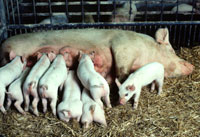Food and Drug Administration
-
Latest E. coli outbreak should prompt rethink of industrial agriculture
For the ninth time since 1995, California’s Salinas Valley — the “nation’s salad bowl” — has been implicated in an E. coli scare involving salad greens. Avoid E. coli, buy L. coli. Photo: iStockphoto As I write this, no definitive explanation has emerged for the latest outbreak, this one involving pre-washed, bagged spinach. But while […]
-
How can junk-food makers label goods laden with partically hydrogenated oil
Long a staple of industrial food processors, partially hydrogenated oils are widely known to have health-ruining effects.
After decades of looking the other way as study after study emerged documenting this phenomenon, the FDA is finally making moves to at least encourage consumers to avoid them. The industry is already retrenching, removing the vile stuff from popular junk-food products, often heralded by a "0 Grams Trans Fat" label on the package.
Restaurant chains such as McDonalds' own Chipotle Grill have followed suit. Archer-Daniels Midland and Monsanto have even forged an evil alliance to market a genetically altered, trans-fat-free soybean oil that mimics some of the properties manufacturers have come to love about partially hydrogenated oil.
Yet does any of this mean anything at all?
I ask because many potato/corn chip labels I've seen declare "trans fat free" in one place and then casually list partially hydrogenated oil on their ingredient lists. Don't believe me? Check this out.
From what I can tell, when a fat has undergone partial hydrogenation -- making it solid at higher temperatures, mimicking that grand and blameless ingredient, butter -- it becomes a trans fat. For practical purposes, trans fat and partially hydrogenated oil are synonymous.
How do they get away with it?
-
Genetically modified animals could make it to your plate with minimal testing — and no public input
Last January, inspectors with the U.S. Food and Drug Administration paid a visit to the University of Illinois, where researchers have been studying the DNA of pigs. The pig project, based in Champaign-Urbana, is one of dozens of experiments being conducted across the country in which scientists are altering the genetic structure of animals in […]
